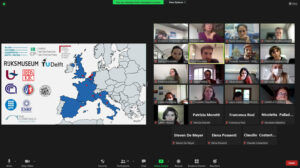Historical Materials BAG: a pilot for community-driven science-based group access
The Historical Materials beamline access group (BAG) had their first BAG beamtime at ID22 on 29-30 September 2021. During this session, 77 samples were analysed, with on-site participation of 4 PhD students C. Costantino (CNR SCITEC), C. Chauffeton (IRCP), N. Palladino (C2RMF), I. Fazlic (ESRF), and the BAG coordinator V. Gonzalez (ENS Paris Saclay). Commenting on the session, V. Gonzalez tweeted, “this is the first beamtime of our Heritage Materials BAG, involving fourteen research groups from six European countries. Exciting years of research ahead!”.
The Historical Materials BAG is a pilot project to test one of three new access models that have been proposed through the STREAMLINE project and under consideration for implementation for the benefit of any similar groups of users.
STREAMLINE is an H2020 funded project that complements the ESRF-EBS upgrade by enhancing user operation through new procedures, services and systems. Through STREAMLINE, the ESRF is investigating new access models aiming to increase productivity and to ensure the sustainability of research with the new ESRF-EBS source. The models will be adapted to the science carried out at the ESRF and taking into account the European landscape, as well as to the expected shortening of measurement times thanks to the brighter X-ray source and resulting anticipated increase in experiments, users and proposals.
Significant progress has already been made in the implementation of mail-in services and remote access that was in response to the travel restrictions put into place for the Covid-19 pandemic. This work was an excellent basis on which to build towards a more custom-built solution for those areas most likely to benefit from new fully-integrated mail-in services. Discussion involving ESRF scientists, User Office, Management, Science Advisory Committee and selected users keen on implementing new access models adapted for certain communities or techniques has resulted in the identification of three potential new access models based either on beamline access groups (BAG) or science hubs, as follows:
♦ Community-driven technique-based BAG;
♦ Community-driven science-based BAG;
♦ ESRF as a science hub in selected areas.
In order to assess the development work required at the ESRF to support such potential new access modes and also to assess their impact on communities, three pilot proposals have been created, one for each of the above categories, and submitted for the proposal round of April 2021:
♦ MI-1397 (Eakins): Shock BAG studying materials under rapid and extreme loading, on ID19;
♦ HG-172 (Gonzalez): Historical Materials BAG studying degradation of paintings, on ID13 and ID22;
♦ MA-4929 (Lyonnard): Grenoble Battery Hub, on 19 different beamlines across 9 of the 12 review panels.
All three pilot projects are essentially a grouping of a large number of PIs and proposals normally submitted individually to the ESRF into one single proposal. The beam time request in each pilot proposal corresponds approximately to the beamtime typically awarded in the past to this particular group of PIs via individual standard proposals.
Essentially the BAG-style access mode follows the principle of the MX BAG access mode that has been running successfully for over 20 years. It groups a number of independent PIs working on similar scientific or technical projects, such that a block allocation of beam time is given and the community of users decides between themselves which projects have priority for use of allocated beamtime. This ensures a reduction in the down time created when changing between proposals and experiment teams, and allows the community experts to decide the priorities in the field. BAG access nurtures an increased level of flexibility for both users and beamline staff due to guaranteed regular beam time slots.
The Hub access mode is different in that it groups a number of PIs working on the same major scientific theme, but who should collaborate and work together to coordinate the beamtime use and share results obtained in such a way that progress is faster and more impactful across the field, rather than made incrementally by the different PIs working separately. This necessitates the sharing of knowledge and of beamtime data and results, prior to publication. The field of battery research was chosen as the pilot proposal for this first hub access, with the CEA Grenoble chosen to initiate this hub.
The first meeting of the Historical Materials BAG took place virtually on 20 October 2021, attended by 23 ESRF users. The group are planning for their next beamtime late in November, which will be at beamline ID13. Already many PhD students have shown interest in participating. In addition to the analyses of samples from their own research, each trip to the ESRF provides them with the opportunity to extend their own networks and to building future collaborations.
Further details of the Historical Materials BAG: https://www.esrf.fr/BAG/HG172

